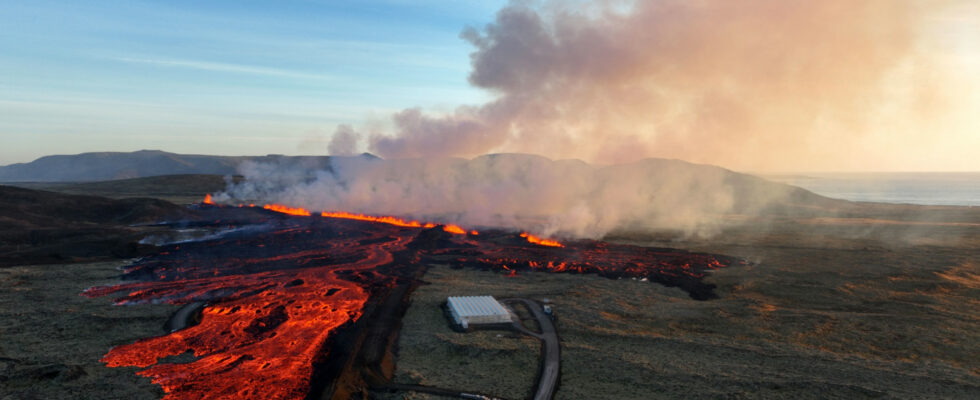A volcano erupted on Sunday near the fishing port of Grindavik, in southwest Iceland, whose residents were urgently evacuated overnight. Seismic activity accelerated sharply during the night and the few dozen residents who were resettled in Grindavik were evacuated around 3:00 a.m. (local and GMT), according to Icelandic public radio and television.
The ongoing volcanic eruption in southwest Iceland reached the port of Grindavik on Sunday where two houses caught fire after being hit by lava, according to surveillance images broadcast by public television.
Fifth volcanic eruption in three years
The eruption began around 8 a.m. north of Grindavik, according to the Icelandic Meteorological Office (IMO), and surveillance images show large flows of bright orange lava along two fissures. “A new fissure has opened just outside the city limits of Grindavik,” the IMO said in a new midday bulletin. The Office announced early in the morning that a first crack had been created “on both sides of the defenses which began to be built north of Grindavík”, approximately 450 meters from the town.
“The city has already been successfully evacuated overnight and no lives are in danger, but infrastructure could be threatened. Flights are not interrupted,” Icelandic President Guðni Th. Jóhannesson said in a message on X (ex Twitter). For the mayor of Grindavik, Fannar Jónasson, the new crack “creates a new situation” but “we can’t do anything”, he told RUV, deeming the situation worrying.
A new volcanic eruption began in the early morning just north of Grindavík. The town had already been successfully evacuated overnight and no lives are in danger, although infrastructure may be under threat. No interruptions to flights. For updated information follow @RuvEnglishpic.twitter.com/9mlOiMohC4
— President of Iceland (@PresidentISL) January 14, 2024
This is the fifth volcanic eruption in Iceland in almost three years, the previous one taking place on the evening of December 18 in the same area, located about forty kilometers southwest of the capital Reykjavik. Grindavik, a small town of 4,000 inhabitants, was evacuated on November 11 as a precaution after hundreds of earthquakes caused by the movement of magma under the earth’s crust – a precursor to a volcanic eruption. These earthquakes damaged the city, creating large cracks in the roads and in houses and public buildings.
Disappearance of a 51-year-old Icelander
Shortly after the eruption of December 18, residents were allowed to return there briefly and then permanently since December 23, before being urgently evacuated during the night. Only a few dozen residents had returned to their homes. Authorities on Saturday evening issued an order to evacuate the city by Monday due to seismic activity and its impact on existing crevasses in the city. So they had to pick up the pace during the night.
This decision also follows the disappearance on Wednesday of a 51-year-old Icelander who was working to fill a crevice in a private garden when the ground suddenly gave way under his feet. After intense searches for 48 hours, the authorities decided to put an end to it Friday evening due to the dangerous nature of the place. The man, who was not found, had fallen more than thirty meters into a crevasse.
Geothermal power plant
The authorities are carefully monitoring the Svartsengi geothermal power plant, located in the same area and which provides electricity and water to around 30,000 inhabitants of the region, and whose installations are protected by a wall. “What matters is where the lava flows. It is now very important to monitor it,” explained Kristín Jónsdóttir, IMO volcanologist at RUV.
Until the March 2021 eruption, the Reykjanes Peninsula, south of the capital Reykjavik, had been spared from eruptions for eight centuries. There were four others, in August 2022 and July 2023, on December 18, 2023 and this Sunday morning, a sign, for volcanologists, of a resumption of volcanic activity in the region. Four days after the December 18 eruption, authorities declared that volcanic activity had stopped but could not say whether the eruption was over, due to possible lava flows underground. Thirty-three volcanic systems are considered active in this country of fire and ice, the most volcanic region in Europe.
